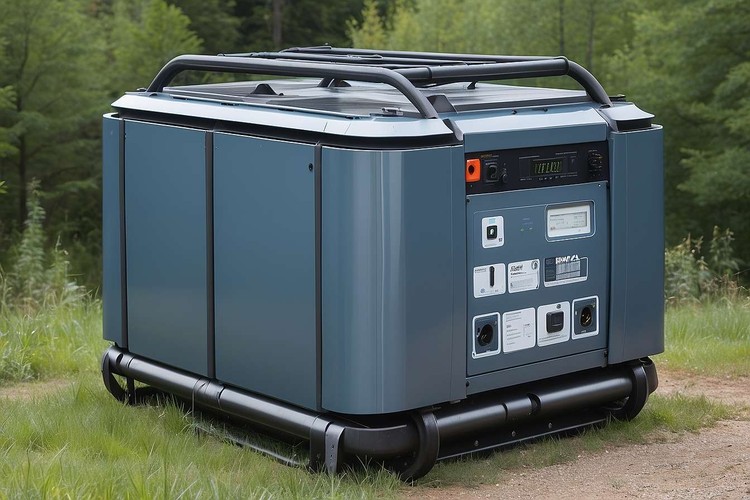Discover the Top 7 Portable Power Stations for Camping and Emergencies in 2025
Choosing the right portable power station can provide silent, clean energy to your devices during emergencies or outdoor trips. Explore the best 2025 models with guidance on capacity, charging speed, and budget to keep you powered on the move and ready for any situation.

Portable Power Stations: What They Are and Why They Matter
Portable power stations are rechargeable lithium-ion battery packs integrated with inverters, providing a quieter, emission-free alternative to traditional gas generators. They serve as backup power during outages, supply electricity while camping or working remotely, and conveniently charge multiple electronic devices off the grid. Typical features include:
- Silent operation: Unlike gas generators, these operate quietly, ideal for camping or indoor emergency use.
- Emission-free: They store electric energy without fuel combustion, eliminating noise and pollution.
- Multiple outputs: Including AC outlets, USB ports, car sockets, and sometimes wireless charging.
- Solar compatibility: Many allow recharging via solar panels for off-grid energy replenishment.
- Varied portability: Units range from lightweight devices under 10 pounds to larger wheeled stations for heavier power needs.
Jackery Explorer 2000 Plus — High-Capacity and Versatile
- Capacity: 2,042.8Wh base; expandable with external battery packs.
- Power Output: 3,000-watt pure sine wave inverter, safe for sensitive electronics and various appliances.
- Charging Speed: About 2 hours using AC or solar input.
- Features: Robust design with wheels and handle, wireless charging, MPPT solar controller, app control, modular battery expansion.
- Price: Around $1,999.
Overview: This unit blends power, flexibility, and portability, ideal for those requiring longer off-grid use or emergency preparedness. Its modular battery system lets users scale capacity, and the pure sine wave inverter protects sensitive devices.
Jackery Explorer 1000 Plus — Mid-Capacity, Expandable
- Capacity: 1,260Wh, expandable up to roughly 5,000Wh.
- Power Output: 2,000-watt continuous.
- Charging Time: About 1.5 hours via AC; up to 3 hours with solar panels.
- Battery Type: LiFePO4 battery with extended lifespan.
- Target Users: RV owners, vanlifers, campers needing dependable portable energy.
Overview: This model strikes a balance between power and portability, offering adequate energy for multiple devices or small appliances without being too heavy. Its LiFePO4 battery ensures greater durability and more cycles.
EcoFlow River 3 — Compact Power for Small Devices
- Capacity: 245Wh.
- Output: 300 watts.
- Weight: Approximately 7.8 pounds.
- Charging Time: Around 1 hour for full recharge.
- Features: UPS functionality with rapid switchover, solar and generator input, multiple USB ports.
- Price Range: About $159–$179 on sale.
Suitable Use: Perfect for users needing to power phones, laptops, and other low-wattage gadgets during short trips or minor outages. Its small size and fast recharge enhance portability.
Bluetti AC70 — Fast Charging and Flexible Power
- Capacity: 768Wh with roughly 93% usable.
- Output: 1,000 watts continuous, peaking at 2,000 watts with Power Lifting Mode.
- Charging Speed: Reaches 80% charge in about 33 minutes.
- Features: UPS mode, app control, solar input.
- Price: Approximately $379 on sale (MSRP around $700).
Benefits: Quick charging and capability to briefly power some high-demand devices make it suitable for various power needs at an affordable price.
Bluetti Handsfree 2 — Power Pack Integrated into a Backpack
- Capacity: 512Wh with about 87% usable.
- Output: 700-watt AC.
- Design: Built into a 60-liter water-resistant (IPX4) backpack with compartments for camera and gear.
- Charging: Full recharge in about 1 hour; supports 100W solar panels.
- Ideal For: Outdoor photographers, hikers, and anyone needing hands-free, mobile power in remote locations.
Key Feature: Combines energy storage with comfortable wearability, enabling simultaneous charging of multiple electronics on the move.
Anker Solix F3800 Plus — Large Capacity Backup with EV Charging
- Capacity: 3,840Wh, expandable.
- Output: 6,000 watts dual-voltage.
- Solar Input: Supports up to 3,200 watts.
- Features: LFP battery for longevity, app-based Storm Guard emergency features, multiple AC and RV outlets, electric vehicle charging enabled.
- Weight: About 97 lbs with wheels.
- Target Users: Homeowners needing substantial backup, off-grid residents, and EV owners.
Description: Designed as a substitute for traditional generators for whole-house backup, capable of powering appliances like refrigerators and dryers for extended periods. Solar input and EV charging increase its versatility.
Additional Options to Consider
- Grecell T-1000: 888Wh capacity, rugged design; budget-friendly for campers.
- DJI Power 500: Quiet 512Wh unit ideal for content creators needing silent operation and fast charging.
- Jackery Explorer 300: Lightweight (under 7 pounds), 293Wh capacity for light camping or remote work.
- Anker Solix C1000: Mid-size, fast recharge with multiple AC outlets; good for off-grid camping with diverse power demands.
Assessing Power Needs
Smaller devices like phones, laptops, and cameras generally require 200-300Wh units (e.g., EcoFlow River 3 or Jackery Explorer 300). Mid-sized stations around 1,000Wh accommodate multiple devices or small appliances, such as Jackery Explorer 1000 Plus or Anker Solix C1000. Extended use powering refrigerators or heaters favors large, expandable units like Jackery Explorer 2000 Plus or Bluetti AC70. Whole-home backup and EV charging need higher wattage systems like the Anker Solix F3800 Plus.
Balancing Portability and Capacity
Larger batteries usually weigh more and are less portable. Wheeled models improve mobility but are less suited for hiking or backpacking. Hybrid designs, such as the Bluetti Handsfree 2, offer a middle ground by combining portability with adequate power for specific use cases.
Charging Speed and Options
Faster AC charging minimizes downtime. Solar compatibility is vital for prolonged off-grid use. UPS functionality ensures continuous power during outages, crucial for sensitive electronics.
Budget Considerations
Prices vary widely: budget-friendly units often cost $150 to $400; mid-range models typically run from $700 to $2,000. Higher-end whole-home systems exceed $2,000. Aligning your budget with your power needs prevents overspending.
For versatile camping and emergency preparedness, the Jackery Explorer 2000 Plus offers large capacity, modular flexibility, and relatively rapid charging. Budget-limited users or those with smaller power demands may prefer the EcoFlow River 3 or Bluetti AC70. Portable backpack-integrated power like the Bluetti Handsfree 2 suits outdoor professionals requiring mobile charging. Homeowners seeking full backup and EV charging might consider the Anker Solix F3800 Plus. Each model caters to different power and portability preferences, showcasing the range of options available in 2025.
Sources
- CNET: Best Tested Portable Power Stations in 2025
- OutdoorGearLab: The 5 Best Power Stations of 2025
- Popular Mechanics: The 7 Best Portable Power Stations for Outages and Outings
Disclaimer: All content, including text, graphics, images and information, contained on or available through this web site is for general information purposes only. The information and materials contained in these pages and the terms, conditions and descriptions that appear, are subject to change without notice.




